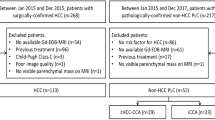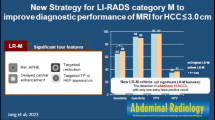Abstract
Purpose
To evaluate the prevalence of major and ancillary imaging features from liver imaging reporting and data systems (LI-RADS) version 2014 and their interreader agreement when comparing hepatocellular carcinoma (HCC) to intrahepatic cholangiocarcinoma (ICC) and combined tumor (cHCC-CC).
Methods
The Institutional Review Board approved this HIPAA-compliant retrospective study and waived the requirement for patients’ informed consent. Patients with resected HCC (n = 51), ICC (n = 40), and cHCC-CC (n = 11) and available pre-operative contrast-enhanced MRI were included from 2000 to 2015. Imaging features and final LI-RADS category were evaluated by four radiologists. Imaging features were compared by Fisher’s exact test and interreader agreements were assessed by κ statistics.
Results
None of the features were unique to either HCC or non-HCC. Imaging features that were significantly more common among HCC compared to ICC and cHCC-CC included washout (76%–78% vs. 10%–35%, p < 0.001), capsule (55%–71% vs. 16%–49%, p < 0.05), and intralesional fat (27%–52% vs. 2%–12%, p < 0.002). Features that were more common among ICC and cHCC-CC included peripheral arterial phase hyperenhancement (40%–64% vs. 10%–14%, p < 0.001) and progressive central enhancement (65%–82% vs. 14%–25%, p < 0.001). The interreader agreement was moderate for each of these imaging features (κ = 0.41–0.55). Moderate agreement was also achieved in the assignment of LR-M (κ = 0.53), with an overall sensitivity and specificity for non-HCC malignancy of 86.3% and 78.4%, respectively.
Conclusion
HCC and non-HCC show significant differences in the prevalence of imaging features defined by LI-RADS, and are identified by radiologists with moderate interreader agreement. Using LI-RADS, radiologists also achieved moderate interreader agreement in the assignment of the LR-M category.



Similar content being viewed by others
References
Torre LA, Bray F, Siegel RL, et al. (2015) Global cancer statistics, 2012. CA: A Cancer J Clin 65(2):87–108
Beyene TJ, Hoek H, Zhang Y, Vos T (2015) Causes of death C. Global, regional, and national age-sex specific all-cause and cause-specific mortality for 240 causes of death, 1990–2013: a systematic analysis for the global burden of disease study 2013. Lancet 385(9963):117–171
Siegel RL, Miller KD, Jemal A (2016) Cancer statistics, 2016. CA: A Cancer J Clin 66(1):7–30
Llovet JM, Zucman-Rossi J, Pikarsky E, et al. (2016) Hepatocellular carcinoma. Nat Rev Dis Prim 2:16018
Bruix J, Boix L, Sala M, Llovet JM (2004) Focus on hepatocellular carcinoma. Cancer cell 5(3):215–219
Zheng J, Kuk D, Gonen M, et al. (2016) Actual 10-year survivors after resection of hepatocellular carcinoma. Ann Surg Oncol 24:1358–1366
Jarnagin WR, Weber S, Tickoo SK, et al. (2002) Combined hepatocellular and cholangiocarcinoma: demographic, clinical, and prognostic factors. Cancer 94(7):2040–2046
Chantajitr S, Wilasrusmee C, Lertsitichai P, Phromsopha N (2006) Combined hepatocellular and cholangiocarcinoma: clinical features and prognostic study in a Thai population. J Hepato-biliary-pancreatic Surg 13(6):537–542
Yin X, Zhang BH, Qiu SJ, et al. (2012) Combined hepatocellular carcinoma and cholangiocarcinoma: clinical features, treatment modalities, and prognosis. Ann Surg Oncol 19(9):2869–2876
Sapisochin G, Fidelman N, Roberts JP, Yao FY (2011) Mixed hepatocellular cholangiocarcinoma and intrahepatic cholangiocarcinoma in patients undergoing transplantation for hepatocellular carcinoma. Liver Transplant 17(8):934–942
Valverde A, Bonhomme N, Farges O, et al. (1999) Resection of intrahepatic cholangiocarcinoma: a Western experience. J Hepato-biliary-pancreatic Surg 6(2):122–127
Kim SA, Lee JM, Lee KB, et al. (2011) Intrahepatic mass-forming cholangiocarcinomas: enhancement patterns at multiphasic CT, with special emphasis on arterial enhancement pattern–correlation with clinicopathologic findings. Radiology 260(1):148–157
Chung YE, Kim MJ, Park YN, et al. (2009) Varying appearances of cholangiocarcinoma: radiologic-pathologic correlation. Radiographics 29(3):683–700
Fowler KJ, Sheybani A, Parker RA 3rd, et al. (2013) Combined hepatocellular and cholangiocarcinoma (biphenotypic) tumors: imaging features and diagnostic accuracy of contrast-enhanced CT and MRI. AJR Am J Roentgenol 201(2):332–339
Bruix J, Sherman M (2011) American association for the study of liver D. Management of hepatocellular carcinoma: an update. Hepatology 53(3):1020–1022
Mitchell DG, Bruix J, Sherman M, Sirlin CB (2015) LI-RADS (liver imaging reporting and data system): summary, discussion, and consensus of the LI-RADS management working group and future directions. Hepatology 61(3):1056–1065
Singh AK, Nachiappan AC, Verma HA, et al. (2010) Postoperative imaging in liver transplantation: what radiologists should know. Radiographics 30(2):339–351
Davenport MS, Khalatbari S, Liu PS, et al. (2014) Repeatability of diagnostic features and scoring systems for hepatocellular carcinoma by using MR imaging. Radiology 272(1):132–142
Barth BK, Donati OF, Fischer MA, et al. (2016) Reliability, validity, and reader acceptance of LI-RADS-an in-depth analysis. Acad Radiol 23(9):1145–1153
Bashir MR, Huang R, Mayes N, et al. (2015) Concordance of hypervascular liver nodule characterization between the organ procurement and transplant network and liver imaging reporting and data system classifications. J Magn Reson Imaging 42(2):305–314
Landis JR, Koch GG (1977) The measurement of observer agreement for categorical data. Biometrics 33(1):159–174
Park HJ, Jang KM, Kang TW, et al. (2016) Identification of imaging predictors discriminating different primary liver tumours in patients with chronic liver disease on gadoxetic acid-enhanced MRI: a classification tree analysis. Eur Radiol 26(9):3102–3111
Joo I, Lee JM, Lee SM, et al. (2016) Diagnostic accuracy of liver imaging reporting and data system (LI-RADS) v2014 for intrahepatic mass-forming cholangiocarcinomas in patients with chronic liver disease on gadoxetic acid-enhanced MRI. J Magn Reson Imaging 44(5):1330–1338
Potretzke TA, Tan BR, Doyle MB, et al. (2016) Imaging features of biphenotypic primary liver carcinoma (hepatocholangiocarcinoma) and the potential to mimic hepatocellular carcinoma: LI-RADS analysis of CT and MRI features in 61 cases. AJR Am J Roentgenol 207(1):25–31
Huang B, Wu L, Lu XY, et al. (2016) Small intrahepatic cholangiocarcinoma and hepatocellular carcinoma in cirrhotic livers may share similar enhancement patterns at multiphase dynamic MR imaging. Radiology 281(1):150–157
Xu J, Igarashi S, Sasaki M, et al. (2012) Intrahepatic cholangiocarcinomas in cirrhosis are hypervascular in comparison with those in normal livers. Liver Int 32(7):1156–1164
Hwang J, Kim YK, Park MJ, et al. (2012) Differentiating combined hepatocellular and cholangiocarcinoma from mass-forming intrahepatic cholangiocarcinoma using gadoxetic acid-enhanced MRI. J Magn Reson Imaging 36(4):881–889
Author information
Authors and Affiliations
Contributions
Study concepts and study design, N. H., R. K. G. D.; literature search, N. H., R. K. G. D.; image review, I. N., N. L., S. G., L. M.; clinical information review, J. Z., L. M. P., A. S., W. R. J., N. H.; statistical analysis, J. Z., M. C.; manuscript drafting and edition, N. H., R. K. G. D., I. N., J. Z., J. Z.; approval of final version of submitted manuscript, all authors.
Corresponding author
Ethics declarations
Funding
This work was supported in part by NIH/NCI P30 CA008748 Cancer Center Support Grant.
Conflict of interest
The authors have declared that no competing interests exist.
Ethical approval
This article does not contain any studies with human participants or animals performed by any of the authors.
Rights and permissions
About this article
Cite this article
Horvat, N., Nikolovski, I., Long, N. et al. Imaging features of hepatocellular carcinoma compared to intrahepatic cholangiocarcinoma and combined tumor on MRI using liver imaging and data system (LI-RADS) version 2014. Abdom Radiol 43, 169–178 (2018). https://doi.org/10.1007/s00261-017-1261-x
Published:
Issue Date:
DOI: https://doi.org/10.1007/s00261-017-1261-x




